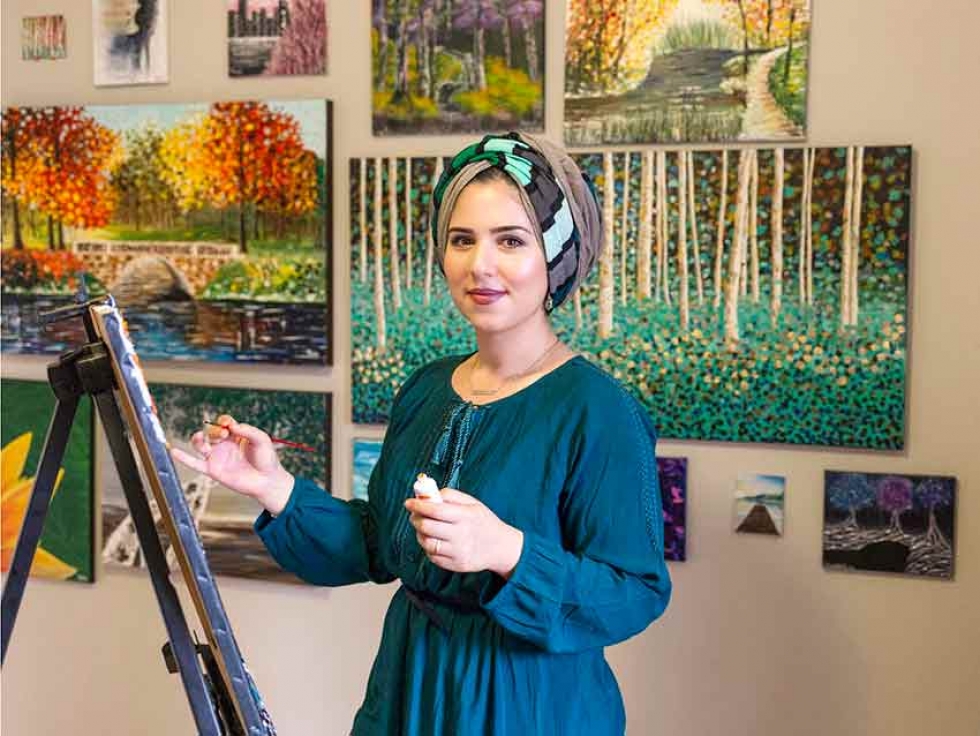
Jun
Expression by Nada: Interview with Self-Taught Syrian Canadian Artist Nada Khatib
Written by Aicha LasfarWhen picturing a successful artist or painter, many people assume they must have been some kind of child prodigy whose finger paintings were far above and beyond the rest of their class.
In the case of self-taught professional painter Nada Khatib, she started painting later in life around 16 years old and didn’t swan dive into the world of art entrepreneurship until her mid/late 20’s.
Her journey isn’t a straightforward one, but one almost as colourful and bold as her many paintings. Now mostly self-employed, she loves her work and is passionate about helping others discover their creative streak.
Muslim Link got in touch with Nada to ask her about her background, her journey into art and any advice she has for young entrepreneurs who would like to spread their wings too.
First off, can you tell us a little bit about yourself and your background?
My parents are Syrian refugees and came to Canada about 35 years ago. I was born and raised in Toronto and lived there my whole life until 2016 when I moved to Bahrain and lived there for a year and a half. In 2018, I moved back to Canada from Bahrain, and decided to live in Calgary.
I started painting when I was around 16 years old. I was just curious and felt it was something I could enjoy so I took it upon myself to try it out. After painting for several years for fun, I had my first exhibit in Toronto in 2015 and it was successful but even then, I never thought that I could paint full-time as a career. Now, in my late twenties, my life path has led me to art full-time. I sell my own original artwork and also teach drawing to children and do some workshops and painting classes.
When did you first get interested in art?
I was never the kind of teen who was always making art or anything like that but I was always a creative person and artistic in a lot of different ways.
My dad actually painted a lot back in Syria when he was growing up although he went to school for engineering. In Syria, art is definitely not seen as a good profession or something you do as a career, so he never really pursued it at all and it was always just a hobby for him. He dropped it and let it go when he was in his twenties and hasn’t painted much since.
When I was younger, I heard about and got to see a couple of his paintings and so I think that made me kind curious. I’m very similar to my dad in many ways so maybe I thought I could try painting too.
Nobody pushed me to it. I was never in any classes and it’s not really something anyone in my family or surrounding emphasized or encouraged me to do.
It was always hard to find time to paint when it was a hobby so I would often I would do it at night when everyone was asleep and it was just my own little thing that I picked up and enjoyed. Every once in a while I would stop and think my dream is to be an artist but then I would just move along with my life because it was just a dream and I really never realized you can make dreams happen.
How would you say that you taught yourself and how did your personal style evolve over time?
One of my first paintings was paint by number; I think that’s as basic as you can get! Another first was a still life apple and a bowl. When I started to do more painting, I began looking online for inspiration and to see what artists were doing. This was before Instagram and social media, so I would just google image search “original painting” and maybe that would help me a find a cool artist’s website. Images of art online were not at all as readily accessible as they are today where you can see over half a billion images under the hashtag “art”.
I found a couple of artists I really began to admire, namely Leonid Afremov. I was so struck by his paintings and he quickly became one of the most inspirational people to me in the beginning of my journey. His paintings are very colorful, bold and beautiful so he inspired several of my earliest paintings.
Being self-taught, I quickly became good at replicating something and that’s how I was able to teach myself. Then as time went on, I challenged myself to be completely original. It’s was a hard exercise to have nothing in mind and no references then to sit in front of a canvas and paint something, but I starting practicing that because that is what I felt would make me a “real” artist. With lots of practice, I was able to learn my own techniques for painting and being creative like taking different elements from several references then putting them together in a unique way.
You use the palette knife as your go-to tool and technique, how did you get into using it?
The first few paintings were done with brushes but through discovering Leonid Afremov, I was introduced to palette knife painting. I learned that is how he created his beautiful texture and I just knew immediately that is something I wanted to do so I went out and bought some. I think I’m drawn to colourful and textured paintings because they’re just very lively, bold and it gives me life in a way that feels satiating and fulfilling. I found my style through using palette knives. I’d be painting and that’s just what I would gravitate towards and I felt that picking them up would help me achieve the result that I was craving. Now every single one of my paintings are done with palette knives and here and there I use a paint brush for a small portion.
In addition to making and selling your paintings, you’re also an art instructor. How did you go from just painting at home to teaching others how to do it?
We moved back from Canada from Bahrain and I thought that I would have to get a regular job because it was a like a difficult time and I was wondering if I could afford to just jump into art or whether to do something else. It didn't take much time to learn that most artists need multiple streams of income. So I decided to get a part time art related job. I thought about working in a gallery or something like that but I ended up landing a Paint Nite job. So I taught painting for Paint Nite while I painted regularly in my studio and built up my Instagram page.
I don’t work for Paint Nite anymore but it was the perfect side gig in my early art career. I learned and grew from that experience then a time came when I knew it was time to move on and build on it.
Now I’m doing my own private events and I invested in my own supplies. I’m enjoying it and I think there’s a demand for it so I’m excited about having my own creative workshops and paint sessions run by me!
I will have a part time job but now I teach drawing to children. Having a part time job or multiple streams of income as an artist is important and a great way to get out there, to be in the community, be around people who like art because I think it can generally be isolating to be an artist if you work from home.
How do you like teaching people how to paint and how does it makes you feel to see people who don’t see themselves as artistic explore that side of themselves?
In every class, I ask if there’s anyone who hasn’t painted before and there’s often a couple of people who haven’t. It excites me like I almost can’t believe they’ve never painted and I hope that they have a good experience. Hopefully it’s something they enjoy so that they can continue to do it as a something therapeutic, relaxing or just an enjoyable hobby.
I love painting with people, it’s definitely my favourite thing out of my part time jobs. It’s so exciting to see how everyone’s painting comes out completely different; it’s very unique to each person and no two can be the exact same. Generally people have a great time and they are amazed at how, when you break it down and do it step by step, they’re able to achieve a beautiful painting.
How do you think your painting sessions benefit people who don’t picture themselves as artistic?
I think it’s especially beneficial for those people. All of us have an artist inside of us or at least a creative side that wants to express itself. It’s always really nice to challenge people to do that, and I think they benefit either by just having a relaxing and enjoyable activity or that they push themselves and they’re surprised by the results.
I always encourage creative freedom and for people to make the painting their own and incorporate anything that they want. People do that sometimes, they’ll take it in a different direction; maybe there’s a certain colour that they’re drawn to and that’s great and I really encourage that.
What would you say are the pros and cons of pursuing art full time?
I would say some of the pros are being your own boss, managing your own time, not having to report to anybody and having general freedom in life. I’ve worked in the corporate world for over 5 years and I’ve done the 9-5, the commute and all of that and I’m so much happier making my own schedule and doing things at my pace.
Another pro is the versatility of what I do. No two days are the same, there’s always different stuff going on and I am always learning something and so that always keeps things interesting, it’s not dull at all.
And the cons?
A con that I discovered the hard way is isolation. It’s very isolating to work from home unless you put in the work to reverse that or to make it better. I didn’t know what to expect and I didn’t have anybody as a mentor to whom I could ask what it’s like to work from a home studio. What I learned is that I need to have some kind of community and I need to be volunteering and going to certain kinds of art spaces that I like and that I enjoy. I’ve been able to do that now but it had been a struggle for months and there were times where I didn’t feel like myself when I felt feelings of sadness that were foreign to me, and I think its because of the isolation.
Find volunteer opportunities, find a cool art organization and see how you can get your foot in the door. Maybe you have a little part time job and between that and studio days, you’re going to have a nice dynamic and balance where you’re not alone in your studio all the time.
Another con is definitely that you are a jack of all trades; you do everything and you’re the only person at the end of the day running the show. Everything falls on you, if you don’t do anything, nothing happens. It’s a growing experience and worth it in the end, but it’s challenging.
I believe that there’s the artist that makes the artwork and then there’s the businessman or woman who makes the same. Making art is one thing and selling it is another. You can make a whole bunch of art and call yourself an artist but if no one sees it and buys it then you’re not a business.
The last thing I would say is the inconsistency and unpredictability of the nature of this field. You never know, sometimes you can make 3 sales in a day and then there’s nothing for a week or two. Being OK with that and keeping your head up and your optimism during the hard times and then just enjoying the good times.
What advice would you have for any young person who would like to become a creative entrepreneur?
Teach yourself about business and marketing.You need to have very specific goals and you need to have very specific ideas of how you’re going to generate income because that’s the most important thing. Are you selling originals, prints? Where are you selling and how? What’s your business strategy? How will you grow? You can figure this all out if you are persistent, dedicated, competent and tech savvy.
Being an artist is very romanticized like, “I can paint all day every day with my music and tea” but unfortunately that’s not the reality! So much of the work behind the scenes is research and emails, going here and there trying different things and it’s a lot of other stuff to actually make the sale and go from A to B. I do think it’s very important not to neglect the business side of things; you really need both for it to work as a career. The good news is that is something you can work on for sure!
Follow Nada Khatib on Instagram here
To view and purchase art by Nada Khatib on Etsy, click here
This article was produced exclusively for Muslim Link and should not be copied without prior permission from the site. For permission, please write to info@muslimlink.ca.















